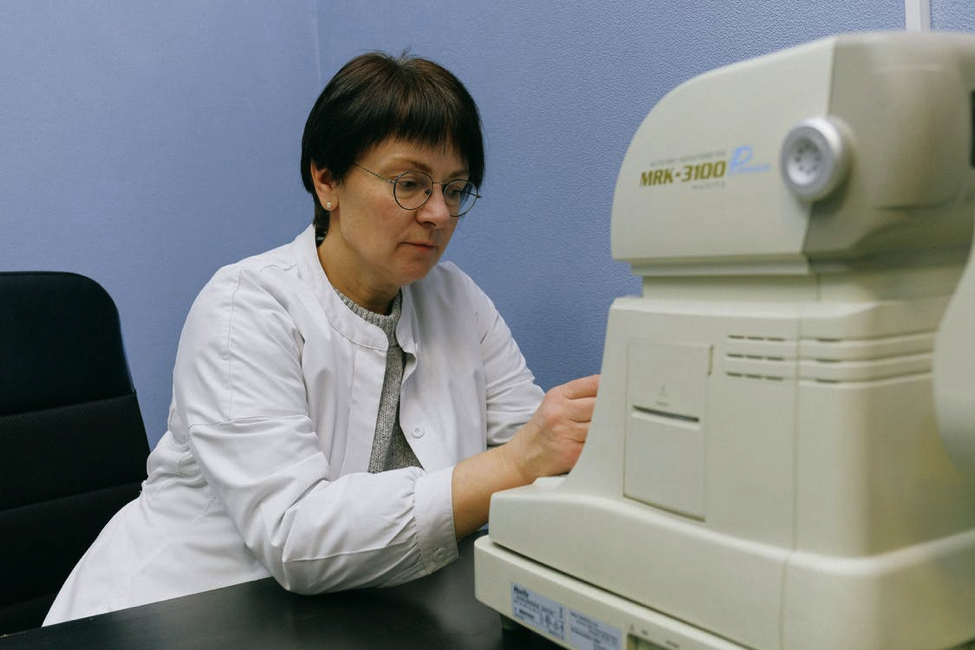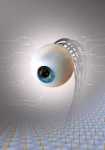Author Interviews, Ophthalmology, Technology / 18.06.2020
Sci-Fi Bionic Eye Gets Closer to Reality with Curved Retina Coated with Nanowires
MedicalResearch.com Interview with:
 Prof. FAN Zhiyong PhD
University of California, Irvine
HKUST School of Engineering
MedicalResearch.com: What is the background for this study? What are the main findings?
Response: According to the report of The World Health Organization, there are over 252 million people suffering from visual impairment globally and 15 million of them are difficult to cure by conventional medical methods. However, today, even the best bionic eyes have only 200 clinical trials, less than 1 ppm of all the patients, mainly due to their poor performance and high cost. The huge gap in supply and demand triggers the study of bionic eyes with performance comparable to human eyes. One important reason for their poor performance is the mismatch in shape between the flat bionic eyes and concave sclera. To protect the soft tissue in eyes from being damaged by the bionic surface, the implanted bionic eyes have to be small. This has limited the sensing area and further the electrodes number, and finally yielded poor image sensing characters with low resolution and narrow field-of-view.
In this work, we are trying to achieve high performance image sensing by biomimeticing human eyes. The high-density NWs are well aligned and embedded in a hemispherical template to serve as retina. The conformal attachment of bionic eyes with sclera enables the large sensing area and wide visual angle. In addition, each individual high-density nanowires can potentially work as an individual pixel. By addressing these challenges, our device design has huge potential to improve the image sensing performance of bionic eyes.
(more…)
Prof. FAN Zhiyong PhD
University of California, Irvine
HKUST School of Engineering
MedicalResearch.com: What is the background for this study? What are the main findings?
Response: According to the report of The World Health Organization, there are over 252 million people suffering from visual impairment globally and 15 million of them are difficult to cure by conventional medical methods. However, today, even the best bionic eyes have only 200 clinical trials, less than 1 ppm of all the patients, mainly due to their poor performance and high cost. The huge gap in supply and demand triggers the study of bionic eyes with performance comparable to human eyes. One important reason for their poor performance is the mismatch in shape between the flat bionic eyes and concave sclera. To protect the soft tissue in eyes from being damaged by the bionic surface, the implanted bionic eyes have to be small. This has limited the sensing area and further the electrodes number, and finally yielded poor image sensing characters with low resolution and narrow field-of-view.
In this work, we are trying to achieve high performance image sensing by biomimeticing human eyes. The high-density NWs are well aligned and embedded in a hemispherical template to serve as retina. The conformal attachment of bionic eyes with sclera enables the large sensing area and wide visual angle. In addition, each individual high-density nanowires can potentially work as an individual pixel. By addressing these challenges, our device design has huge potential to improve the image sensing performance of bionic eyes.
(more…)
 Prof. FAN Zhiyong PhD
University of California, Irvine
HKUST School of Engineering
MedicalResearch.com: What is the background for this study? What are the main findings?
Response: According to the report of The World Health Organization, there are over 252 million people suffering from visual impairment globally and 15 million of them are difficult to cure by conventional medical methods. However, today, even the best bionic eyes have only 200 clinical trials, less than 1 ppm of all the patients, mainly due to their poor performance and high cost. The huge gap in supply and demand triggers the study of bionic eyes with performance comparable to human eyes. One important reason for their poor performance is the mismatch in shape between the flat bionic eyes and concave sclera. To protect the soft tissue in eyes from being damaged by the bionic surface, the implanted bionic eyes have to be small. This has limited the sensing area and further the electrodes number, and finally yielded poor image sensing characters with low resolution and narrow field-of-view.
In this work, we are trying to achieve high performance image sensing by biomimeticing human eyes. The high-density NWs are well aligned and embedded in a hemispherical template to serve as retina. The conformal attachment of bionic eyes with sclera enables the large sensing area and wide visual angle. In addition, each individual high-density nanowires can potentially work as an individual pixel. By addressing these challenges, our device design has huge potential to improve the image sensing performance of bionic eyes.
(more…)
Prof. FAN Zhiyong PhD
University of California, Irvine
HKUST School of Engineering
MedicalResearch.com: What is the background for this study? What are the main findings?
Response: According to the report of The World Health Organization, there are over 252 million people suffering from visual impairment globally and 15 million of them are difficult to cure by conventional medical methods. However, today, even the best bionic eyes have only 200 clinical trials, less than 1 ppm of all the patients, mainly due to their poor performance and high cost. The huge gap in supply and demand triggers the study of bionic eyes with performance comparable to human eyes. One important reason for their poor performance is the mismatch in shape between the flat bionic eyes and concave sclera. To protect the soft tissue in eyes from being damaged by the bionic surface, the implanted bionic eyes have to be small. This has limited the sensing area and further the electrodes number, and finally yielded poor image sensing characters with low resolution and narrow field-of-view.
In this work, we are trying to achieve high performance image sensing by biomimeticing human eyes. The high-density NWs are well aligned and embedded in a hemispherical template to serve as retina. The conformal attachment of bionic eyes with sclera enables the large sensing area and wide visual angle. In addition, each individual high-density nanowires can potentially work as an individual pixel. By addressing these challenges, our device design has huge potential to improve the image sensing performance of bionic eyes.
(more…)
Author Interviews, COVID -19 Coronavirus, Duke / 27.03.2020
Little Evidence COVID-19 Can Be Spread Through Tears
MedicalResearch.com Interview with:
Dr. Rupesh Agrawal, MD
Associate Professor
Senior Consultant Ophthalmologist
Duke-NUS Medical School, Singapore
MedicalResearch.com: What is the background for this study?
Wasn't Dr Li Wenliang, the Chinese physician who first alerted his community of coronavirus an opthalmologist, with possible exposure to tears from this surgical work with glaucoma patients?
Response: Since the start of the pandemic, there have been multiple reports which suggested the transmission of SARS-CoV-2 via ocular fluids. As ophthalmologists, we come into close contact with tears on a daily basis during our clinical examination. Furthermore, many equipment in the clinic like the Goldman tonometer come into direct contact with such ocular fluids, providing a channel for viral transmission. The evidence, as of date, were mainly anecdotal reports included in newspaper articles and media interviews. We wanted to know if the virus can truly be found in tears, so we decided to embark on this study. (more…)
Author Interviews, JAMA, Ophthalmology, University of Michigan / 16.03.2018
Ophthalmology Consultation for Emergency Care at a University Hospital
MedicalResearch.com Interview with:
Maria A. Woodward, MD, MSc
Department of Ophthalmology and Visual Sciences
W. K. Kellogg Eye Center
Institute for Healthcare Policy and Innovation
University of Michigan
Ann Arbor, MI
MedicalResearch.com: What is the background for this study? What are the main findings?
Response: Many people go to emergency departments seeking care for their eye problems. We wished to investigate which factors are associated with the involvement of ophthalmologist consultants in the care of these patients and whether any disparities exist. (more…)
Author Interviews, Ophthalmology, Technology / 22.01.2018
Tunable Lens Allows Detailed Imaging of Entire Eye
MedicalResearch.com Interview with:
Ireneusz Grulkowski, PhD
Assistant Professor
Bio-Optics & Optical Engineering Lab
Institute of Physics
Nicolaus Copernicus University
MedicalResearch.com: What is the background for this study?
Response: The ophthalmic diagnostics has undergone a revolution over the last 30 years. The access to new modalities allowed to understand the process of development of different eye diseases of the retina and the anterior segment. In particular, optical coherence tomography (OCT) demonstrated the feasibility in visualization of microarchitecture of the ocular tissues. However, most of the ophthalmic equipment is dedicated either to imaging the anterior segment of the eye (e.g. the cornea) or to retinal imaging. This is due to the fact that the eye is composed of the elements, such as the cornea and the lens, that refract the light.
In this report, we wanted to address that challenge. We compensated the refractive power of the eye by the application of the tunable lens. The focus tunable lens is the example of active optical element that changes its focal distance with the applied electric current.
(more…)
Author Interviews, JAMA, Ophthalmology, Pediatrics / 14.01.2018
Retinopathy in Premature Infants: Low Dose Ranibizumab May Be Effective Without Systemic Side Effects
MedicalResearch.com Interview with:
Prof. Dr. Andreas Stahl
Geschäftsführender Oberarzt
Leiter Arbeitsgruppe Angiogenese
Universitätsaugenklinik Freiburg | University Eye Hospital Freiburg
Freiburg, Germany
MedicalResearch.com: What is the background for this study?
Response: Retinopathy of prematurity (ROP) is a sight-threatening disease and one of the main reasons for irrreversible bilateral blindness in children. Particularly infants born at very early gestational ages or with very low birth weight are affected. In these infants, vascularization of the retina is unfinished at the time of birth. Severeal weeks into the life of these very prematuerly born infants, angiogenic growth factors, mainly vascular endothelial growth factor (VEGF), become upregulated in the avascular parts of the retina, leading to a re-activation of physiologic vascular growth. If all goes well, these re-activated retinal blood vessels progress towards the periphery and lead to a fully vascularized and functional retina. If, however, the vascular activation by VEGF is too strong, then vascular growth becomes disorganized and vessels are redirected away from the retina and into the vitreous. If left untreated, these eyes can then proceed towards tractional retinal detachment and blindness.
Since the 1990s, the standard method of treating ROP has been laser photocoagulation of avascular parts of the retina. This treatment is sensible because VEGF as the main angiogenic driver of pathologic blood vessel growth is expressed in these avascular parts of the retina. The downside of laser treatment, however, is that treated retinal areas are turned into functionless scar tissue and are lost for visual function. In addition, infants treated with laser need to be under general anesthesia for hours during treatment which can be troublesome in very young and fragile preterm infants. And in the long run, infants treated with laser have a high risk of developing high myopia in later life.
(more…)
Author Interviews, Infections, Ophthalmology / 26.08.2014
Bacteria Causing Eye Infections Increasingly Resistant To Common Antibiotics
 MedicalResearch.com Interview with
Ronald C Gentile, MD, FACS, FASRS
Professor of Ophthalmology
Chief, Ocular Trauma Service (Posterior Segment)
Surgeon Director
The New York Eye and Ear Infirmary of Mount Sinai
New York, NY 10003
President: operationrestorevision.org
Medical Research: What are the main findings of the study?
Dr. Gentile: We had three main findings in our study on the microbiological spectrum and antibiotic sensitivity in endophthalmitis over the past twenty- five years at the New York Eye and Ear Infirmary of Mount Sinai.
First Finding: The first main finding of the study was that there has not been any major change in the types of organisms causing endophthalmitis over the past 25 years. The most common cause of endophthalmitis in the study was bacteria, 95%, with most, 85%, being Gram-positive bacteria. The most prevalent organisms isolated were coagulase-negative staphylococcus, making up about 40% of the cases. This was followed by Streptococcus viridans species in about 12% and Staphylococcus aureus in about 11%. Gram-negative organisms accounted for about 10% and fungi for about 5%.
Second Finding: The second main finding of the study was that the current empiric intravitreal antibiotics used for treating endophthalmitis, vancomycin and ceftazidime, continue to be an excellent choice. The overwhelming majority of microorganisms causing endophthalmitis are susceptible to this combination. Over 99% of the Gram-positive isolates were susceptible to the vancomycin and about 92 percent of the Gram-negative isolates were susceptible to ceftazidime.
Third Finding: The third main finding of the study was that there was increasing microbial resistance to eight antibiotics including cefazolin, cefotetan, cephalothin, clindamycin, erythromycin, methicillin/oxacillin, ampicillin, ceftriaxone and decreasing microbial resistance to three antibiotics including gentamicin, tobramycin, and imipenem. For example, Staph Aureus isolates resistant to methicillin increased from 18% in the late 1980s to just over 50% this past decade while gentamicin-resistance endophthalmitis isolates decreased during the same time period from 42% to 6%.
(more…)
MedicalResearch.com Interview with
Ronald C Gentile, MD, FACS, FASRS
Professor of Ophthalmology
Chief, Ocular Trauma Service (Posterior Segment)
Surgeon Director
The New York Eye and Ear Infirmary of Mount Sinai
New York, NY 10003
President: operationrestorevision.org
Medical Research: What are the main findings of the study?
Dr. Gentile: We had three main findings in our study on the microbiological spectrum and antibiotic sensitivity in endophthalmitis over the past twenty- five years at the New York Eye and Ear Infirmary of Mount Sinai.
First Finding: The first main finding of the study was that there has not been any major change in the types of organisms causing endophthalmitis over the past 25 years. The most common cause of endophthalmitis in the study was bacteria, 95%, with most, 85%, being Gram-positive bacteria. The most prevalent organisms isolated were coagulase-negative staphylococcus, making up about 40% of the cases. This was followed by Streptococcus viridans species in about 12% and Staphylococcus aureus in about 11%. Gram-negative organisms accounted for about 10% and fungi for about 5%.
Second Finding: The second main finding of the study was that the current empiric intravitreal antibiotics used for treating endophthalmitis, vancomycin and ceftazidime, continue to be an excellent choice. The overwhelming majority of microorganisms causing endophthalmitis are susceptible to this combination. Over 99% of the Gram-positive isolates were susceptible to the vancomycin and about 92 percent of the Gram-negative isolates were susceptible to ceftazidime.
Third Finding: The third main finding of the study was that there was increasing microbial resistance to eight antibiotics including cefazolin, cefotetan, cephalothin, clindamycin, erythromycin, methicillin/oxacillin, ampicillin, ceftriaxone and decreasing microbial resistance to three antibiotics including gentamicin, tobramycin, and imipenem. For example, Staph Aureus isolates resistant to methicillin increased from 18% in the late 1980s to just over 50% this past decade while gentamicin-resistance endophthalmitis isolates decreased during the same time period from 42% to 6%.
(more…)


